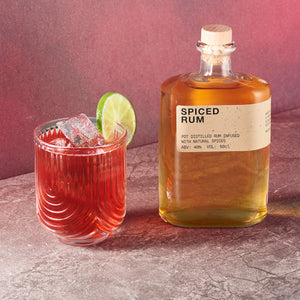You have no items in your shopping cart.
Last orders for Christmas 22nd December! Also shipping on 29th / 30th for New Year tipples!
40%+, All Products
Smooth and syrupy with black figs and dried dates mingled with molasses and hints of treacle. Fig rum offers the taste of Christmas on the palate with notes of vanilla,...
£27.00
40%+, All Products
Expect rich dark cocoa flavours with bitter chocolate notes. This rum works brilliantly in a White Russian style cocktail or with some ginger beer. It also works great served neat...
From £16.00 To £27.00
40%+, All Products
Each pack contains a 10cl bottle of our Rums chosen from our core and seasonal flavours so you can try them out and see which style suits you best. The...
£25.00
40%+, All Products
Fresh ginger, kaffir lime, orange peel, vanilla and a handful of spices come together to give this rum rich, round earthy tones with high citrus notes. TASTING NOTES Nose Ginger...
From £16.00 To £27.00
40%+, All Products
Brazilian Fazendo Pantano coffee beans are infused with our rum to create a deep, complex coffee flavour with notes of caramel and a praline nuttiness. TASTING NOTES Nose Steam from...
From £16.00 To £27.00
40%+, All Products
Smooth and creamy with pronounced caramelised banana flavour, complemented by subtle vanilla and spice undertones Banana rum offers a delightful tropical aroma with sweet, ripe banana at the forefront. On...
From £16.00 To £27.00
40%+, All Products
Edinburgh’s historic shores are no strangers to the exotic and the exceptional, with plenty of delicious cargoes welcomed across its cobbles. Today, we’re proud to continue that centuries-old tradition, bringing...
£33.95
Origin of Rum
The history of rum can be traced back to Barbados in 1650 when it was first distilled on sugarcane plantations and was known as ‘Rumbullion’. Plantation slaves discovered that the sugarcane molasses (a syrup that is produced in the sugar-making process) could be fermented into alcohol and distilled to create a pure spirit. There are earlier references to rum in India and the Canary Islands, but it is in the Caribbean where it was first traded and sold. Rum also has somewhat of a dark past as by the late 17th Century slaves were commonly exchanged for rum by African slave traders.
From the West Indies, its popularity quickly spread to the American colonies with rum distilleries appearing on New York’s Staten Island and in Boston, New England. It is estimated that before the American War of Independence that every adult and child was consuming three imperial gallons of rum each year. This love of rum continued after the war with even George Washington insisting on a barrel of rum at his 1789 presidential inauguration.
Rum is also strongly associated with the Navy where sailors were given a daily ration of the spirit until this was abolished in 1970. Diluting rum with water, known as ‘grog’, was a common practice and from 1756 Navy regulations required that lemon juice be added to this mixture to prevent scurvy. This rum was a popular item for pirates to plunder, characterised by the familiar song ‘Yo-ho-ho, and a bottle of rum’.
How Rum is made
Rum is either made from fresh fermented sugar cane juice or produced from molasses. The raw sugar cane is harvested and then crushed to extract the juice before being distilled in a column or pot still. Most rums are then aged to develop the flavour often in bourbon or whiskey casks. Individual distilleries then add their own slant on the spirit to give it its unique edge. Our Keepr’s Honey Spiced Rum is made using a triple-distilled rum from our partners at List Distillery in Florida and then infused here in the UK with honey from our own hives, cinnamon, ginger and nutmeg spices, and Cotswold spring water. This unique blend creates a vanilla, cinnamon and honeyed sweetness on the palate.
Different types of Rum
Heavy, dark and full-bodied rums are the oldest types of rum, like those produced in Barbados. These are aged in bourbon or whiskey casks and traditionally enjoyed neat, although they are now more commonly served with mixers. Rum can also be light in colour like Cuban or Puerto Rican rums, which are best in cocktails. These are aged for less time than other varieties and you will have most likely enjoyed them in that traditional Cuban highball – the Mojito. A more recent phenomenon is the rise in popularity of flavoured and spiced rums in the last decade. Spices and ingredients like coconut and honey can add sweetness or heat to the rum making this type of rum extremely versatile. Brilliant in a hot toddy in the winter or in a Cuba Libre cocktail in the summer for a real taste of the tropics wherever you are.
How to drink Rum: Rum Cocktails and garnishes
One of the simplest ways to enjoy rum, apart from serving it neat, is by adding a dark mixer like cola or ginger beer. In spiced rums the ginger beer gives the drink some extra fire to the flavour while drinking it with cola is essentially a Cuba Libre cocktail without the lime. The Cuba Libre, like the Mojito, is another cocktail native to the island of Cuba. A highball traditionally made with white rum, it combines tropical rum notes with the sparkling spicy flavour of cola and adds a shot of lime to cut through the sweetness.
Another popular white rum cocktail is the Daiquiri. Allegedly created by an American in the small Cuban town of Daiquiri, hence the name, at the turn of the 20th Century, it is essentially three ingredients: rum, lime juice and sugar syrup. Of course, bartenders have added their own twists to this through the years adding flavours such as strawberry, Maraschino liqueur, grapefruit and banana.
For dark rums, we’d recommend a Rum Collins of a Dark ‘N’ Stormy. The Rum Collins is based on the Tom Collins – a long cocktail made with gin, lemon juice and soda water. The gin, however, is replaced by rum and the lemon juice exchanged for lime. In the Dark ‘N’ Stormy rum is topped with ginger beer and garnished with lime. Lime juice and simple syrup can also be added for this national drink of Bermuda.
While rum lends itself perfectly to summer sipping, its complexity of flavour also makes it a pleasing winter drink, especially the spiced rum varieties. As a Rum Old Fashioned, with a teaspoon of honey, a few dashes of Angostura Bitters and garnished with orange peel, it is just the thing to enjoy by the fire on a cold night.
If you’re making rum cocktails at home, you can’t go wrong with any of the above as they are all simple to make and don’t require many ingredients. For rum with mixers, opt for a lime, lemon or orange peel garnish, or if you’re feeling adventurous pineapple works well in that super tropical cocktail the Pina Colada (rum, coconut milk and pineapple juice). Likewise, cherries offer a lovely, sweet contrast to the zesty citrus notes of a Rum Sour.


























